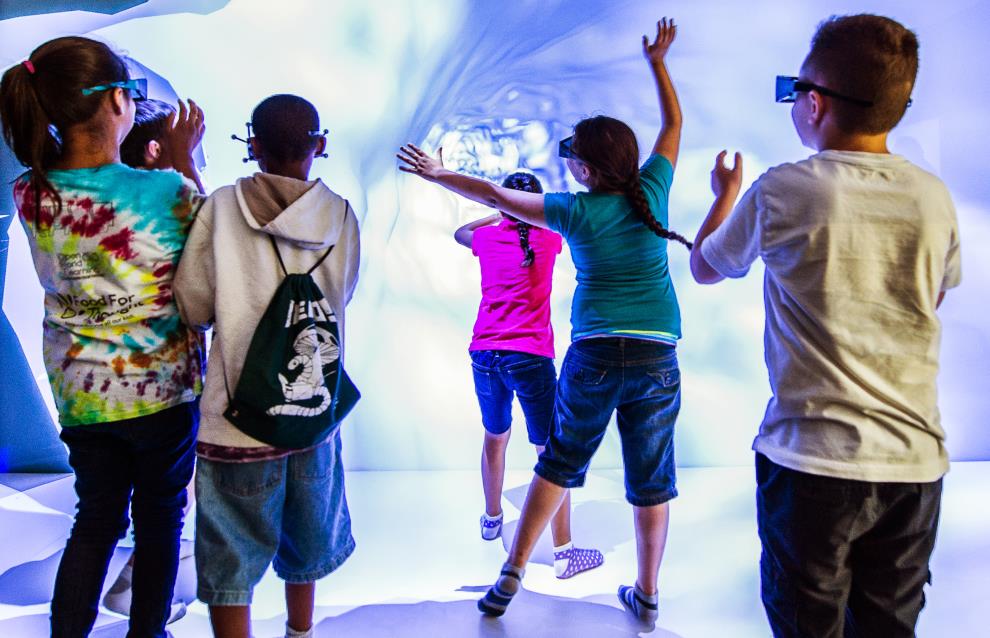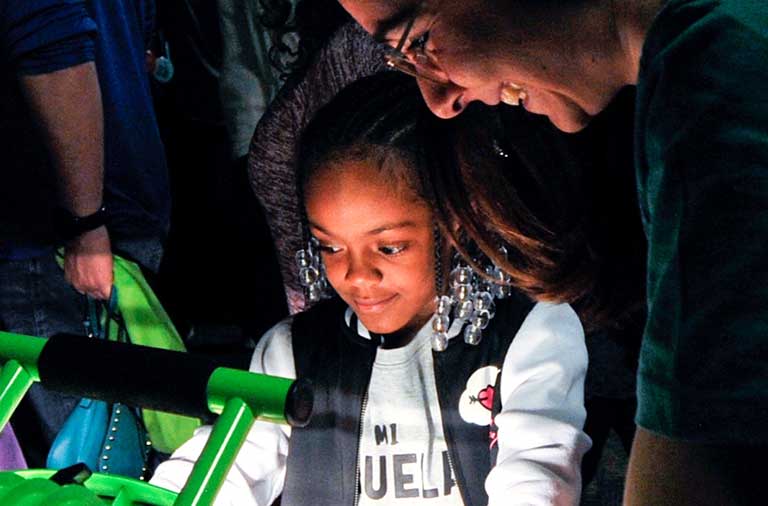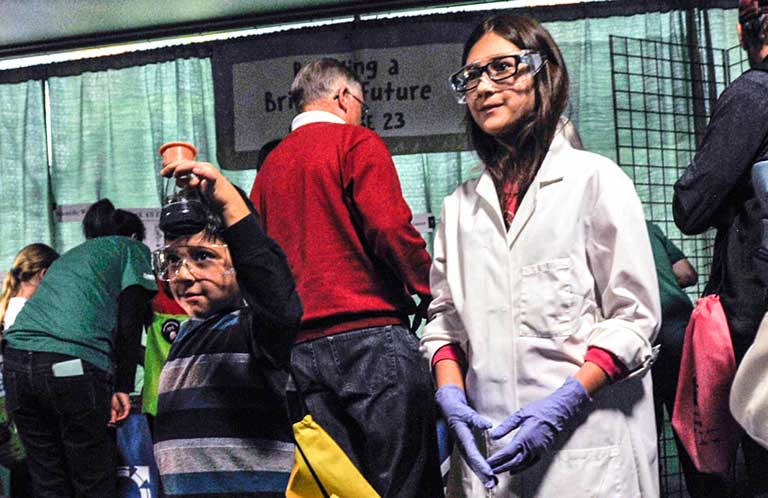Investing in Future Innovation: NREL Researchers, Engineers Introduce Students to STEM Careers

Students from the Open World Learning after-school STEM program interact with a wind turbine simulation at NREL's 3-D Visualization Laboratory. Photo by Dennis Schroeder, NREL 34401
At NREL, the word “investment” is a common one. The laboratory’s work focuses on forward-looking efforts to integrate and optimize energy systems, create new economic opportunities, and bolster U.S. competitiveness in the global energy market—ultimately strengthening our country’s energy security and ensuring reliability and stability for future generations.
But the talented and dedicated researchers and engineers at NREL, and other research laboratories, will eventually retire. That’s why a growing contingent of NREL staff is making a complementary investment: volunteering time and expertise to foster the science, technology, engineering, and math (STEM) workforce of the future. While the number of students pursuing STEM at the college level has increased, many kids—particularly girls—are still losing interest in science before starting high school.
NREL’s Workforce Development and Education Programs team knows that facilitating personal connections between researchers and students considering STEM careers is a key component, not only in developing the next generation of scientists, but also in fostering the future of innovation itself. In addition to leading several of the laboratory’s fourth- to 12th-grade educational programs such as the Colorado High School Science Bowl and Middle School Solar and Lithium-Ion Car Competition, as well as facilitating several undergraduate and graduate internship and mentorship opportunities, the Workforce Development and Education team also has organized several opportunities for NREL scientists and engineers to share their STEM experiences—and they’ve had no shortage of volunteers.

One girl tried out NREL’s hands-on grid activity at this year’s Girls and Science. Photo by Marcus Giron, NREL
“Do you know what a circuit is?”
“Which lightbulb uses less electricity?”
“What do you think will happen when we cover up part of this solar panel?”
These were just some of the snippets of conversation that could be heard coming from NREL’s “clubhouse” at the 2017 Girls and Science event in March at the Denver Museum of Nature and Science. Twenty female NREL researchers and engineers manned the booth, which was visited by thousands of kids (both boys and girls) and parents throughout the day. A spin on the traditional career fair, Girls and Science gives students the opportunity to meet and talk with female scientists while exploring hands-on learning experiences.
Emma Raszmann, an intern studying inverter technologies at NREL, is particularly interested in introducing girls to STEM possibilities. She knows firsthand that, while many middle and high schools have more STEM resources these days (such as entire engineering tracks and 3-D printers) that help keep girls interested in science, it’s not keeping them interested in all branches of science equally.
“During my undergraduate electrical engineering program, it was common to see about 10% women in my classes,” Raszmann said. And showing her aptitude for scientific inquiry, added: “I’m curious why women tend to only go into certain areas of science, like the life sciences. We need to show girls that careers in computer science and engineering are exciting and achievable.”
Another volunteer, Ria Kontou, had only been at NREL for a couple of months as a postdoctoral researcher when she participated in Girls and Science—but she couldn’t pass up the opportunity. She understands the importance of setting a STEM example.
“I grew up in Greece and was never really exposed to any women scientists,” she said. “But I was lucky to have a really good college mentor who opened my eyes to possibilities. I think it’s so important to see someone in that role, to know it’s possible to get there.” She added that, because science is so broad, experiences similar to Girls and Science can help introduce students to paths they would never know existed until they met real people doing work in those areas.
Jennifer Newman—who spent the afternoon showing students the amount of energy needed to light incandescent lightbulbs versus more-efficient LED bulbs—stumbled upon her STEM calling in such a way, but much later. “I was studying meteorology, but took a renewable energy course as an elective during the last semester of my master’s program. I was hooked,” she said. “I had to find a way to bring these two interests together.” Her work at the National Wind Technology Center at NREL involves wind resource assessment, which has a lot to do with weather.
By introducing students to a variety of STEM careers early on, volunteers like Newman hope to help them stumble upon their calling much earlier in life—and were happy to hear that many at the event had already found their paths, announcing “I want to be a coder!” or “I want to be an engineer!” NREL volunteer Jessica Olstad found one girl at the event, however, who would not be swayed by STEM. While helping her with the lab coat, safety glasses, and latex gloves that volunteers brought to the event for the kids to try on, Olstad found that the girl was set on becoming a unicorn rider. “Oh, you like animals?” Olstad asked. When the girl replied that she did, Olstad asked if she’d ever considered becoming a unicorn doctor. “You could be a veterinarian and ride unicorns!” Olstad suggested. “Maybe,” the girl replied, “or I could just ride unicorns.”
Sharing STEM Stories

Young students envisioned themselves as scientists at this year’s Girls and Science event. Photo by Marcus Giron, NREL
Many that volunteered for Girls and Science have also participated in similar opportunities, including recent STEM events for Latino families and local Girl Scout troops. At the Girl Scout and Girls and Science events, volunteer Heidi Tinnesand was interested to see the variety of ways different girls approached hands-on STEM activities. “Some were analytical, reading the instructions and asking questions—some were just bashing things together and experimenting,” she said. “I could already pick out the ones I’d want to work with 10 years from now—I wanted to give them my card!”
Tinnesand also recently volunteered for a “Girls-Only Engineering Day” at a local high school. “It was a really cool event,” she said, describing a setup with various workshops and panel discussions. “Our room had 20 girls interviewing a panel of six professionals. The girls were really engaged and interested, asking how we got into our careers—of course, the path is often non-linear,” she said, echoing stories shared by other researchers and engineers.
Tinnesand wants to broaden the image of women scientists and show girls that STEM can be fun. “I want them to think that science is cool, just like other things in their lives—like having purple hair,” she said. “I think of myself as a ‘weird’ engineer, and I want to share that you don’t have to change your personality to become a scientist.”
Doreen Molk—who works in NREL’s Technology Transfer Office but has done solar cell materials research and taught middle and high school science in the past—is volunteering with a nonprofit organization called Community Resources. The group serves Denver Public Schools by engaging volunteers to share their time, knowledge, and enthusiasm for learning. She’s been paired as an academic mentor with an eighth-grade student who has expressed a strong interest in science.
“She told me about science fair projects she’s done in the past, and I could see she had an interest in environmental remediation and water,” Molk said. “I thought it would be so much more interesting for her if she could meet with some scientists doing active research.” So Molk set up meetings for her mentee with a group of female NREL researchers.
NREL volunteers also can be found at events designed to help undergraduate and graduate students fine-tune their career trajectories. Olstad recently spoke to a group of female Colorado School of Mines students that visited NREL to learn about engineering careers. “An event like that would have been really useful to me when I was at Mines,” she said, knowing that even small pieces of advice at that stage can be extremely helpful. “I told them to take all the internships they could, even if they didn’t get their preferred choices,” she said. “Learning, firsthand, what you don’t want to do can be as important as finding what you love to do.”
“The education I had in engineering school was so amazing in terms of learning to think—learning critical thinking skills—and I want people to learn those skills,” said Tinnesand. “There are lots of challenges in the world, lots of problems to solve, and we need people to solve them.” That’s one of the reasons she believes it’s important to invest time in mentorship opportunities. She also wants the next generation of scientists to feel the freedom to innovate. “When I tell people I’m an engineer, they let me do things, solve problems,” she said. “I feel like I can do practically anything—I can figure it out, I can learn it—and other people believe that in me, too.”
Last Updated May 28, 2025
